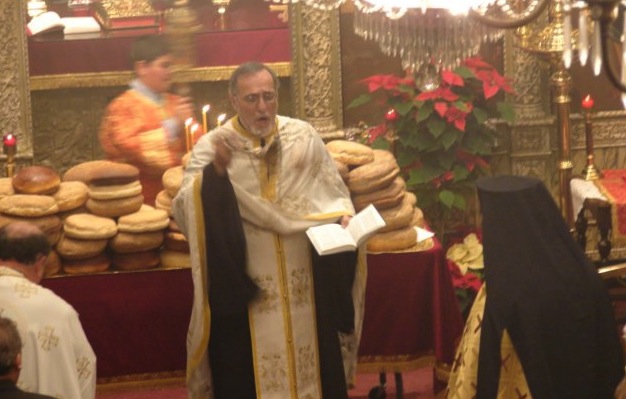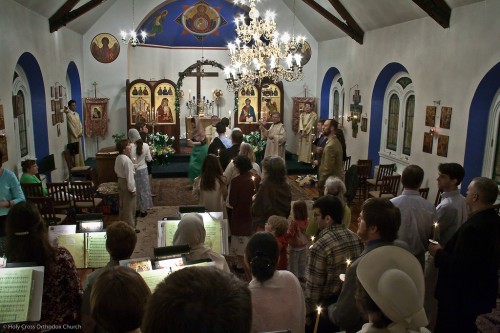Seeing the bigger Orthodox picture at Pascha
 Believe it or not, Orthodox Christians do return to church during the daylight hours on Pascha Sunday, even after the glorious 3-hour-plus liturgical siege that is our midnight celebration of the Resurrection of Christ. After heading home for six hours of sleep (depending on the schedule of each particular parish) and recovery from breaking the long fasting season of Great Lent (no meat or dairy during Lent and Holy Week), we come back to the suddenly quiet, sun-lit sanctuary for a service called Agape Vespers.
Believe it or not, Orthodox Christians do return to church during the daylight hours on Pascha Sunday, even after the glorious 3-hour-plus liturgical siege that is our midnight celebration of the Resurrection of Christ. After heading home for six hours of sleep (depending on the schedule of each particular parish) and recovery from breaking the long fasting season of Great Lent (no meat or dairy during Lent and Holy Week), we come back to the suddenly quiet, sun-lit sanctuary for a service called Agape Vespers.
Yes, Vespers in daylight. It's complicated and another symbol that Easter has turned the world upside down.
It is a tradition, in this service, for the Gospel readings to be shared in as many languages as possible -- depending on the skills and lives of the people in the parish. Our parish -- Holy Cross Orthodox Church in Linthicum, just south of Baltimore city -- is part to the Antiochian Archdiocese (Arab roots), but at least 80 percent of the church consists of converts and/or the children of converts.
One side effect of this is that we have a wide range of ethnic ties in the body of the congregation. Thus, here is the list of languages used in our Agape Vespers on Sunday: Greek, English, Arabic, Armenian, Bulgarian, Cherokee, Creole, Coptic, French, Georgian, German, Hebrew, Gaelic, Italian, Korean, Latin, Romanian, Russian, Slavonic, Spanish and Turkish. We had some people missing, so the list is not as long as it could have been.
The point, of course, is that the Orthodox faith -- big "O" or small "o" -- is bigger than any one ethnicity, heritage or language. The faith is universal.
With that in mind, read the top of the Pascha story in The Baltimore Sun. The headline sets the tone, too.
Baltimore's Greek Orthodox faithful unite for Easter celebration
St. Nicholas is center of Greektown community
This headline, logically enough, leads to this:
Inside Baltimore's St. Nicholas Greek Orthodox Church early Saturday, the Rev. Michael Pastrikos stood on the dais and chanted prayers before an ornate altar adorned with icons of holy figures.
The smell of spiced incense filled the dimly lit sanctuary as the faithful slipped into pews and counted down the hours until their Easter celebration would begin.
They were among the many Orthodox Christians and others around the world and throughout the region celebrating the holiest of weekends using a Julian calendar different from that observed by other denominations. For the parishioners at St. Nicholas, the occasion is both a holy observance and a time to honor their Greek heritage.
After the solemn service, the churchgoers would rest -- and some continued to fast -- until midnight, when they will dine on a special lamb soup and begin their celebration of the risen Christ.
Throughout Holy Week, observant parishioners will spend some 20 hours at the church.
Yes, I have some questions. For starters, I would imagine that the reporter meant to say that the iconostasis, not the altar, was covered with icons (although there would, of course, be many icons inside the altar area behind that icon screen). I also wonder if the worshipers ate that special lamb stew at the traditionally massive feast AFTER the Pascha service. It is, you see, Orthodox tradition for worshipers to fast from all food for about eight hours before taking Holy Communion in the Divine Liturgy.
Details, details. Details, however, are everything in religion-news coverage.
But here is my main problem with this feature. It does not appear that The Sun team truly knows that Baltimore has a quite large, diverse and lively Orthodox community that is, truth be told, larger than this one Greektown area. Yes, I saw the tiny phrase acknowledging that there are other Orthodox believers "throughout the region." That is simply not enough background information.
 Before some readers (especially Greeks) get upset, please let me stress that it's TOTALLY valid to do a news feature that centers on Pascha celebrations at this church -- as an example of how others are celebrating as well.
Before some readers (especially Greeks) get upset, please let me stress that it's TOTALLY valid to do a news feature that centers on Pascha celebrations at this church -- as an example of how others are celebrating as well.
It is also valid to specifically focus on the prominent Greek community. But how do you write a feature story about Pascha without even mentioning the other Orthodox communities in this area or, among the Greeks, without mentioning the prominent Greek Orthodox Cathedral of the Annunciation?
While this Sun story does include a sentence or two of specifically religious content, it seems that the main goal was to describe the ways that Greek life and traditions are interwoven into the larger and universal Orthodox celebration. Once again, let me stress that this approach is valid and understandable. The problem is that the team that handled this article seems to think that what some call, mistakenly, "Greek Easter" is the same thing as the Eastern Orthodox celebration of Pascha.
What's the bottom line? It's fine, it's wonderful, to write about the details of "Greek Easter" at this one parish. However, the Sun team needed at least one or two paragraphs to establish the wider context. The story also needed a bit more info to help readers separate the small-t traditions of this one parish from the large-T Traditions that are essential to the whole wide and complex world of Orthodoxy.
So what does this wider context look like? Consider the opening of this story by Godbeat veteran James Davis down at the South Florida Sun-Sentinel.
Catholics and Protestants may be done with Easter, but South Florida's Eastern Orthodox Christians -- Greek, Syrian, Egyptian and others -- are just getting started: They'll hold theirs this weekend.
Observances for the 10,000-15,000 Orthodox here vary by culture and language, but with the same purpose: to have parishioners relive the crucifixion, burial and resurrection of Jesus.
That's a good start.
TOP IMAGE: A file photo from St. Nicholas Greek Orthodox Church in Baltimore, taken during a celebration of the parish's feast day in honor of St. Nicholas of Myra. Second image: Worshipers begin to enter the Holy Cross sanctuary after the outdoor procession during Pascha in 2009. Yes, that chandelier is swinging -- a symbol of the events of Easter turning the whole world on edge.